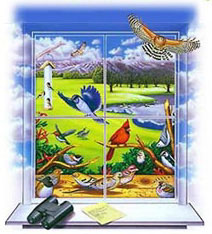Sixth annual Great Backyard Bird Count, Feb. 14-17, expects record participation across North America
By Alison Wells

At a time when birds in North America face survival challenges – ranging from loss of habitat to introduced predators and diseases such as West Nile virus – ornithologists are counting on birders of every age and skill level to keep their eyes open Feb. 14-17. That's the date for the sixth annual Great Backyard Bird Count (GBBC), an Internet-based event that last winter had 47,000 participants identifying millions of commonplace and rare birds.
"This time we need every birder to join us," said Frank Gill, senior vice president of science of the National Audubon Society. "The Great Backyard Bird Count has become a vitally important means of gathering data to help birds, but it can't happen unless people take part. Whether you're a novice or an expert, we need you to take part and help us help birds."
A project of the Cornell Lab of Ornithology and Audubon, with sponsorship from Wild Birds Unlimited, the GBBC combines high-tech Web tools with an army of citizen-scientist bird observers. The GBBC asks families, individuals, classrooms and community groups to count the numbers and kinds of birds that visit their feeders, local parks, schoolyards and other areas during any or all of the four count days. Participants enter their sightings at BirdSource, http://www.birdsource.org/gbbc . The interactive Web site was developed by Audubon and the Cornell lab.
Since 1998 the GBBC has enlisted more than a quarter of a million participants of all ages and backgrounds in the effort to count birds. "When the last ivory-billed woodpecker was seen in the 1930s, there was no concrete way for citizens to help professional ornithologists monitor bird populations," says Cornell Lab of Ornithology Director John Fitzpatrick. Last year he led an expedition to attempt to rediscover the ivory-billed woodpecker. "We cannot allow other species to face the same fate as the ivory-bill. The Great Backyard Bird Count provides a way for citizens to help us determine which birds are where and in what numbers, so we can take steps to protect those that need protecting."Because too many species already are showing population declines. GBBC will put the spotlight on birds that appear on Audubon's WatchList, an accounting of avian species in decline or at conservation risk due to dwindling habitat and other threats. "The WatchList is an early warning system designed to raise awareness of birds in trouble, before they become endangered or threatened," says Audubon's Gill. "Think of the WatchList as preventive medicine."
The GBBC site includes instruction for participation, continually updated results, a vocabulary section, bird-watching and bird-feeding tips and bird vocalizations. Another section of the Web site has information about the house finch eye disease project, the Cornell Lab's ground-breaking study involving citizen scientists. Educators will find suggestions on how to conduct the count with groups of students.
"The Great Backyard Bird Count is a terrific way for individuals, families, schools and community groups to contribute to a better understanding of birds," says Fitzpatick. "In return, they learn more about birds in the process. I can't think of a more enjoyable -- and more rewarding -- way to spend a little time on a late-winter day."
The Cornell Lab of Ornithology is a nonprofit membership institution interpreting and conserving the Earth's biological diversity through research, education and citizen science focused on birds.
*Audubon is dedicated to protecting birds and other wildlife and the habitat that supports them. The growing network of community-based Audubon Centers, grass-roots science programs for bird enthusiasts and advocacy on behalf of ecosystems sustaining important bird populations, engage millions of people of all ages and backgrounds.*
Media Contact
Get Cornell news delivered right to your inbox.
Subscribe